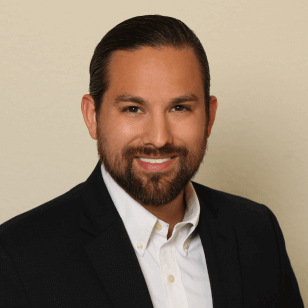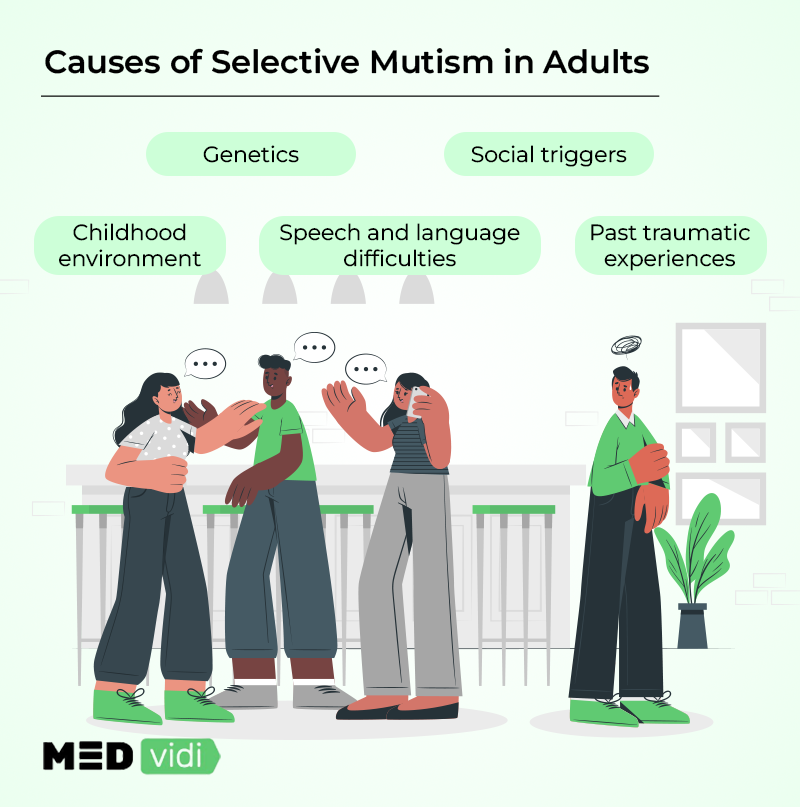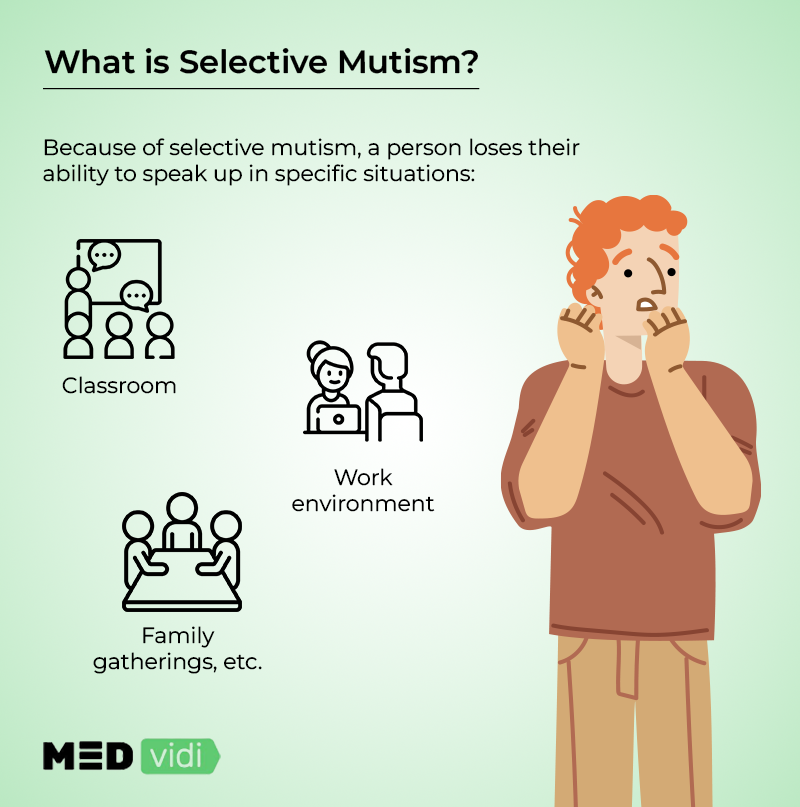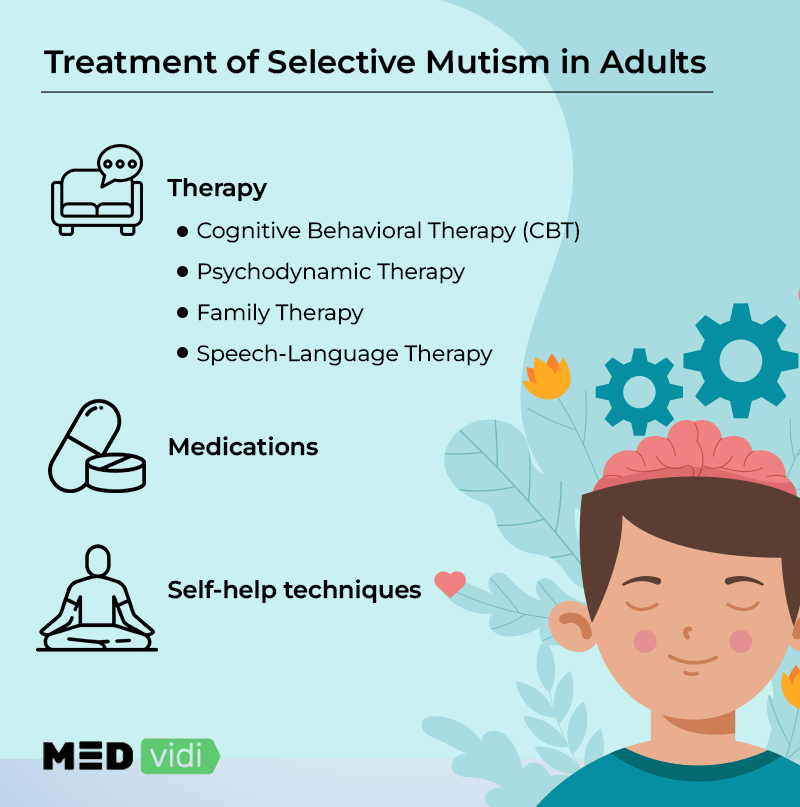Highlights
- Selective mutism is a serious and potentially debilitating mental health condition that can cause you to have severe anxiety and become unable to speak in certain social settings.
- Selective mutism was previously considered a condition that only affects children and adolescents. But it’s now recognized as an anxiety disorder that can affect both children and adults.
- Professional mental health treatment is very effective for helping people recover from selective mutism. Speech and language pathologists can also play a role.
Many of us have felt afraid to speak up in certain situations. But for people with selective mutism — a mental health condition that affects around 0.03-1% of the population, according to the DSM, although
Selective mutism is typically considered a childhood anxiety disorder. However, it can continue into adulthood, especially when it’s left untreated.
In this article, we’ll go over what selective mutism is (and isn’t), how it shows up in adults, and evidence-based ways to overcome this condition.
What Is Selective Mutism?
Selective mutism is a mental health condition that causes you to fail to speak in specific situations. It could happen in the classroom, work environment, or family gatherings. Typically, in other settings, people with selective mutism have no difficulty speaking freely and comfortably. For example, you might be able to speak with your spouse at home, but become unable to at work.
Selective mutism is more than just shyness. It’s not just an unwillingness to speak (i.e. you’re able to speak, but simply choose not to or don’t want to). People with selective mutism become unable to speak in certain situations, even when they want to.
This continues to be a highly misunderstood condition, especially in adults. Adults with selective mutism might be labeled as “strange” or “antisocial.” But it’s critical to understand that this is a serious anxiety disorder that requires treatment.

What Are the Symptoms of Selective Mutism in Adults?
According to the Diagnostic and Statistical Manual of Mental Disorders (DSM) — the text that most mental health professionals use to make diagnoses — the core symptom of selective mutism is “Consistent failure to speak in specific social situations in which there is an expectation for speaking (e.g. at school) despite speaking in other situations.”
In addition, to be diagnosed with selective mutism, you must meet the following criteria:
- Your inability to speak gets in the way of achievement at school or work, or negatively affects your social life.
- You’ve experienced the inability to speak in certain settings for at least one month.
- Your inability to speak is not due to a lack of knowledge or comfort with the language being spoken.
- The inability to speak isn’t better explained by autism, psychosis, or another communication disorder.
Some additional signs and features of selective mutism include:
- Changes in facial expressions in uncomfortable settings.
- Excessive shyness and/or social anxiety.
- Fear of social embarrassment and rejection.
- Some people may use nonverbal communication methods (pointing, nodding, writing, etc.) in conversations.
- Asking a friend or a family member to speak on your behalf in public.
- Difficulty in making new personal and professional relationships.
- Social isolation and withdrawal.
- Temper tantrums or mild oppositional behavior, although this may be more common in children.
- Physical symptoms of anxiety, like a racing heart and sweating, when expected to speak.
Selective Mutism Causes and Risk Factors
Like most other mental health conditions, the exact cause of selective mutism is unclear. We do know that it most often develops during childhood, and that certain risk factors can increase your likelihood of having it.
These risk factors include:
- Genes: Genetics plays a critical role in the development of many mental health problems, and selective mutism likely possesses a genetic component or predisposition. If you have a relative with selective mutism, you may be more likely to have it yourself.
Research also shows[2] that there may be some genetic links between social anxiety disorder and selective mutism. - Childhood Environment: Environmental factors during childhood can also contribute to selective mutism. One theory states that children who come from families that use avoidance as a coping mechanism might be more likely to become selectively mute. A lack of opportunities for social contact as a child could also play a role.
- Trauma: Sometimes, selective mutism
could be a response to a traumatic event[3] . In particular, experiencing dissociation after trauma seems to be linked to selective mutism. However, it’s relatively rare to be able to entirely explain selective mutism as a traumatic response. - Speech and Language Difficulties: Speech delay and other communication issues are common in people with selective mutism. Research shows that
over 1 in 3 children with selective mutism have speech difficulties[3] before they develop mutism. This shows that people could develop selective mutism for fear of mispronouncing words. - Social Anxiety: Selective mutism and social anxiety disorder often appear together. So if you live with social anxiety, then you might be at higher risk of developing selective mutism as well.

Situational Triggers
People with selective mutism can become anxious and unable to speak in any setting. It’s likely that you feel more comfortable speaking in familiar settings with people you feel at ease with. But when you are outside of those comfortable and familiar environments, speaking might become more difficult.
For children, such situational mutism is more likely to show up at school. We don’t have enough research on adults, but following that logic, you might be more likely to experience symptoms at work.
Each adult with selective mutism is unique, and symptoms can show up anywhere. But some situations that might be more likely to be triggering include:
- Dates, especially first dates
- Parties or social gatherings
- Job interviews
- Everyday settings, like checking out at the grocery store
How Is Selective Mutism in Adults Diagnosed?
In previous editions of the DSM, selective mutism was categorized in “disorders of childhood and adolescence.” In the latest edition, selective mutism was moved to the list of anxiety disorders instead. The
To be diagnosed with selective mutism, mental health professionals will compare your symptoms to the diagnostic criteria listed in the DSM (listed above). There’s no single test to evaluate selective mutism. Your provider will probably use a combination of different methods, most importantly observing and asking you about your symptoms.
Your provider may ask you questions like:
- Who are you comfortable and uncomfortable speaking with?
- What driving factors make you remain silent in some situations?
- Where do you consistently fail to talk?
- When do you fail to communicate effectively?
- How do you communicate in such situations?
How Is Selective Mutism Different From Other Conditions?
Some psychological conditions often coexist with selective mutism, and some have overlapping symptoms — that’s why receiving another diagnosis or a dual diagnosis is common. However, subtle differences make selective mutism unique from other conditions:
|
Characteristic Behavior |
Selective Mutism |
|
|
Elective Mutism |
Can speak but chooses to remain silent in certain situations (this is an outdated term and not a recognized mental health condition) |
Wants to speak but is unable to do so in some public settings |
|
Neurogenic Mutism |
Characterized by inability to speak due to brain injury |
No brain injury can explain the inability to speak (sometimes called psychogenic mutism) |
|
Traumatic Mutism |
Not an officially recognized condition; traumatic dissociation can cause complete shutdown of communication |
Silence in specific situations, but not others (may or may not be due to past trauma) |
|
Social Anxiety Disorder |
An anxiety disorder characterized by an extreme fear of humiliation or judgment by others |
Can appear alongside social anxiety disorder, but is a separate condition |
|
Shyness |
A personality trait that can cause quietness or fear of speaking |
A serious mental health condition, not a personality trait |
|
Communication Disorders |
Conditions that are characterized by difficulties, delays, or impediments in speech, language, or hearing |
Inability to speak cannot be explained by communication or language difficulties |
|
Autism Spectrum Disorder |
A lifelong neurodevelopmental condition that has many symptoms, including communication differences |
A mental health condition that cannot be explained by neurodevelopmental issues; can be significantly improved with treatment |

What Is the Treatment of Selective Mutism in Adults?
The treatment of selective mutism in adults is multimodal. Like most anxiety disorders, therapy and medication are the primary forms of treatment for this condition. A combination of both is often what’s most effective.

Therapy for Selective Mutism
Most of the research has been focused on treating selective mutism in children, and we need more research to be able to say for certain what types of therapy are effective for adults. However, cognitive-behavioral therapy (CBT) is thought to be most effective for selective mutism.
CBT is a type of talk therapy that is based on the relationship between our thoughts, feelings, and behaviors. It’s been found to be effective for most anxiety disorders, including selective mutism. In one long-term study, around
For selective mutism, the
Some examples of behavioral techniques for selective mutism used in CBT include:
- Systematic Desensitization: This technique, often used for social anxiety, gradually exposes you to situations that make you anxious, starting with the least scary and moving toward more challenging ones. You might start by imagining a situation, then practicing in low-stress environments, and eventually facing the real-life scenario. Over time, this builds a hierarchy of feared speaking events, making them more manageable.
- Social Skills Training: Working with a therapist, you can learn the social skills needed to feel more comfortable in conversations. This might include starting and keeping a conversation going, reading nonverbal cues, and managing eye contact. Practicing these skills helps reduce social anxiety and makes it easier to participate in situations where speaking is expected.
- Contingency Management: This approach focuses on rewarding verbal communication and not reinforcing staying silent. By recognizing and supporting any attempts to speak, even small ones, you gradually increase your confidence and ability to use your voice in social situations.

Speech-Language Therapy
If you have a speech difficulty that has contributed to the development of selective mutism, then speech-language therapy may also help. Once you address the underlying speech delay or difficulty, you may no longer be anxious about speaking. For children with selective mutism, speech and language pathologists (SLPs) are often important elements of the treatment team.
Some treatment techniques that SLPs may use for selective mutism include:
- Self-modeling involves making video and audio recordings modeled on appropriate behaviors to show adults speaking in situations where they previously kept silent. The recordings are played regularly during the therapy sessions to make patients accustomed to hearing themself talking in various circumstances.
ECHO Program[7] is a structured program that provides opportunities to practice social communication in role plays and games. It was originally developed for children and adolescents, but could be adapted for use with adults.
Medication for Selective Mutism
Some people may also need to take medication for selective mutism. The
Some common antidepressants that have been found to be helpful for selective mutism include:
In some cases, anti-anxiety medications and antipsychotic medications may also be prescribed for selective mutism in adults.
All of these medications can help improve selective mutism by balancing neurochemical levels in the brain, which helps to feel less anxious about speaking in certain situations. These medications are more beneficial when combined with therapy, especially CBT.
Self-Help Tips
It’s important to understand that selective mutism is a serious and potentially debilitating mental health condition that requires professional treatment. But there are certain self-help tips that might help you manage your symptoms as you go through treatment.
Anxiety Management Techniques
Selective mutism is an anxiety disorder, so understanding how to manage anxiety is an important aspect of overcoming it. Specifically, it’s closely related to social anxiety disorder — so self-help tips that are effective for social anxiety could be most helpful.
- Start Small With Social Situations: Triggering social situations can feel impossible when you have selective mutism. But avoiding them can make the anxiety stronger, so the goal is to face them gradually, one step at a time. This might mean saying a word to a cashier, answering a question in class, or just nodding and smiling at someone you know — whatever feels doable.
- Practice Speaking With People You Know: It can help to talk to someone you already feel comfortable with in an anxiety-provoking setting. A friend, family member, or coworker can be a safe practice space. This gives you a chance to build confidence before trying to talk to strangers or in front of a larger group.
- Use Nonverbal Communication: Even when you’re not ready to speak, you can still communicate. Gestures like pointing, nodding, smiling, miming, or making eye contact can carry a conversation forward. Over time, you can start to include small bits of speech alongside these gestures as you feel more comfortable.
- Celebrate Small Wins: Every time you speak in an anxiety-provoking setting, even just a little bit, it’s a success. Rewarding yourself helps reinforce the positive behavior and makes it easier to keep going. This could be something simple, like a treat, a walk, a little time doing something you enjoy.
Find a Supportive Community
It can also help to build a strong support system of people who understand your condition and won’t judge you for it. When you feel judged for selective mutism, it can intensify the cycle and make it even harder to speak in anxiety-provoking situations.
If you don’t have an informal network of support (or even if you do), then you might consider joining a formal support group. In these groups, you can get together with other adults with selective mutism who understand exactly what you are going through.
The Selective Mutism Association lists online and local support groups in select states.
When to Reach Out for Professional Support
It can’t be stressed enough that informal support and self-help alone aren’t likely to lead to a complete recovery from selective mutism. Remember, it is more than just shyness. If you truly live with selective mutism, then you need and deserve professional anxiety treatment.
Early intervention is considered key for children with selective mutism. If you have this condition as an adult, it may be because you didn’t receive the support you needed as a child. Regardless, you deserve support now.
A healthcare provider can create a structured plan to help you gradually face the situations that trigger your selective mutism. They can teach evidence-based strategies, like cognitive-behavioral techniques, and guide you through exposure exercises. With professional support, you can build confidence, reduce anxiety, and start using your voice more consistently in the situations that matter to you.
Takeaway
Selective mutism doesn’t have to stop you from living a full life. Even as an adult, you can learn to manage your anxiety, build confidence, and participate more fully in social, work, and personal situations. With the right professional support and strategies, it’s possible to find your voice and engage in the life you want.
If you think you might be experiencing selective mutism, reach out to experienced healthcare professionals at MEDvidi for the right diagnosis and a personalized treatment plan.
Frequently Asked Questions
Is selective mutism a disability?
Selective mutism can be considered a disability in certain contexts, especially if it significantly impacts work, school, or social functioning. Like all other mental health conditions, its effects are recognized under some disability and education laws, but each case is evaluated individually.
Can selective mutism be cured?
There isn’t a single “cure” for selective mutism, but with professional treatment, therapy, and support, many adults and children can learn to manage their anxiety and speak more confidently in challenging situations.
Is selective mutism a form of autism?
Selective mutism is not a form of autism, though some symptoms, like social withdrawal, can appear similar. It is classified as an anxiety disorder, not a neurodevelopmental disorder.
How long does selective mutism last?
The duration of selective mutism varies; for some, it improves in childhood due to support, while for others it can persist into adulthood if left untreated. Early intervention tends to improve outcomes.
What type of disorder is selective mutism?
Selective mutism is an anxiety disorder, closely related to social anxiety disorder, where fear or extreme discomfort prevents speaking in certain situations.
Can PTSD cause selective mutism?
Post-traumatic stress disorder (PTSD) itself doesn’t directly cause selective mutism, but trauma can increase anxiety and contribute to difficulties speaking in specific situations, which can sometimes worsen or trigger mutism behaviors.












